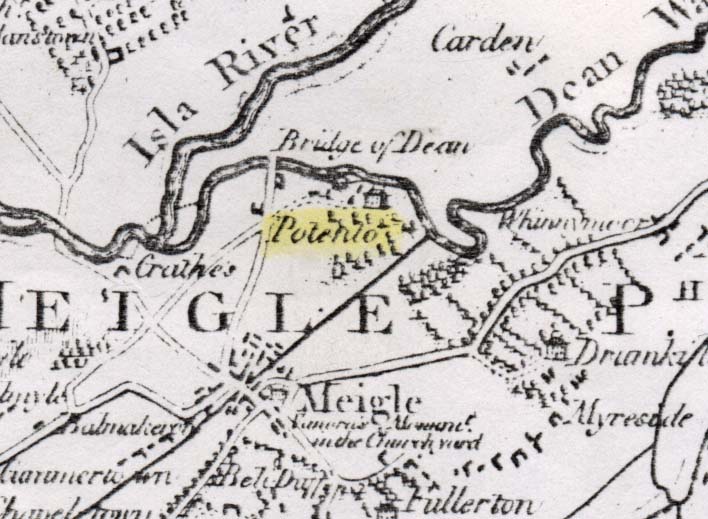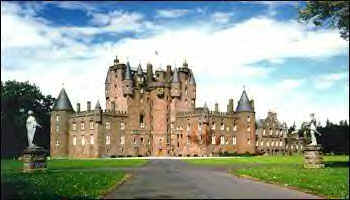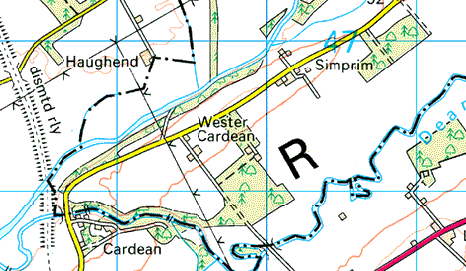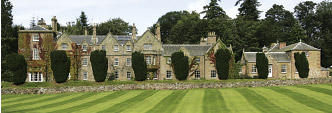
There is very little information available on the web on the ownership of Potento prior to 1800. I was able to determine from papers of the Cox Family (who became the owners in 1872) that the Cardean and Baikie Estate was owned by the Earl of Strathmore in 1785. Potento was one of the properties within that estate.
The Earl of Strathmore would be the logical owner of the property. Meigle is only several miles away from Glamis Castle (below), the seat of the Strathmore family, the richest and most powerful family in the area. (The Queen Mother was a descendent of the Strathmores and grew up in Glamis Castle.) It's entirely likely that at some point in time, the Strathmores owned the entire area. Even as late as 1871, the Strathmores owned property around Meigle. The Scottish Towns web site for Meigle tells us that Sir George Kinlock purchased the village and estate of Meigle from the Earl of Strathmore in 1871 but the estate was long ago broken up in lots.

A Google search under Potento brought up a cryptic reference to Patrick Murray, Laird of Simprim and Potento. As you can see from the map below, Simprim was a short walk from the Dean Bridge. Additional Google searches with this new information disclosed a more complete history.

The Murray family is famous within Scotland. One such Murray was Patrick Murray, 5th Baron, Lord Elibank. (Elibank is in Selkirkshire, south of Edinburgh. However, his main seat was in Ballencrieff Castle, a few miles east of Edinburgh.) The 5th Baron had no children with his wife Margaretta Maria, whom he married in 1735 after her child bearing years were over. (This was her second marriage; her first marriage was with William, 6th Baron North in 1705.) Lord Elibank had two illegitimate children with Mary Mortlock a member of the Elibank staff. One was a daughter (Ann) and the second was a son Patrick. Ann died in Florence in 1843 and her relationahip with the Baron and Mary Mortlock is written on her headstone. She received 5000 pounds from Elibank in 1783 when she married. Patrick received land on Lord Elibank's death.
I've been pretty specific in noting the illegitimate relationship between Patrick Murray and his father because there has been some confusion about that. For example, in a 1987 letter to John Latta Wighton, Rev. Fraser Stewart of the Church of Scotland's Parish of Ardler, Kettings, and Meigle remarked that the Earl of Strathmore sold the Cardean Estate to Patrick Murray, NATURAL son of Lord Elibank in 1785. My understanding is that the Earl of Strathmore sold the property earlier to Lord Elibank perhaps in 1767 or 1778. And, as noted, Patrick Murray's mother was Mary Mortlock. Lord Elibank then bequeathed Patrick Murray the ownership of Potento and Simprim through his will.
(FYI: A brother of 5th Baron Elibank, James Murray, was the first civil governor of Canada in 1763, then called the Province of Quebec, and was instrumental in writing the Quebec Act of 1774.) (FYI#2: In 1857, John Baxter Wighton and his wife Catherine Latta (Generation 5) would give their son John the full name of John Murray Wighton in recognition of a genetic link to the Murray family. I'll discuss this more fully in the biography of John Murray Wighton.)
Patrick Murray's name appeared in a book by J. G. Lockhard who mentioned that Sir Walter Scott visited the young bachelor some time between 1792 and 1797. (The Scott and the Murray families were related.) I believe the longest stay was at Meigle in Forfarshire, the seat of Patrick Murray of Simprim, whose passion for antiquities, especially military antiquities, had peculiarly endeared him both to Scott and Clerk. In the village churchyard, close beneath Mr. Murray's gardens, tradition still points out the tomb of Queen Guinevere; and the whole district abounds in objects of historical interest. Amidst them they spent their wandering days, while their evenings passed in the joyous festivity of a wealthy young bachelor's establishment, or sometimes under the roofs of neighbours less refined than their host.
Patrick Murray's name next appears in the renovation plans for his Arthurstone House property, just west of Meigle, in 1838. (Murray had owned Arthurstone since at least 1823.) The name of the house is reputed to have come from a stone dedicated by the legendary Arthur to his wife Guinevere. The property originally belonged to the Cistercians of Coupar Angus. To give you a sense of Mr. Murray's wealth, I've included a picture of Arthurstone House in the 1990s. Not bad for the illegitimate son of an Earl. (Some further additions were done by owners after Mr. Murray.)

Our last web sighting of Mr. Murray was in August 9th, 1842, when Burke's Peerage reported that his youngest daughter married the 4th Lord Talbert of Malahide, heir to two and a half thousand acres of Scotland. Clearly, we're not talking about peasants here. Patrick Murray died in that same year (1842) (that's what happens when you have to pay for a wedding to a lord) and Simprim and the rest of his holdings were passed to an unspecified number of daughters.
James Carmichael, a jute industrialist, acquired Arthurstone House on or before 1869 (presumably from the Murray descendents). His son-in-law, James Cox, acquired the estate of the Cardean (the lands around Potento and Simprim) in 1878. That acquisition may have been from his father-in-law, or directly from the Murray descendents. James Cox owned one of the largest jute manufacturing companies in the UK. (The Cox factory tower was a landmark in Dundee.) He was also a major figure in the construction of the first and second Tay railway bridges.
The Cardean Estate was sold in 1951 to Lord Elphinstone, Queen Elizabeth's brother-in-law. The reference to that sale included a description of the land holdings within the estate at the time. From this we can determine, at a minimum, that Strathmore's Cardean and Baikie Estate included farmlands of Potento, Western Cardean, Simprim, Braidestone Mill, Blackhill, Westhill, Baitland, and Baikie. It may actually have been larger in the 1730s - we don't know what other properties Strathmore had in the estate that weren't sold to Patrick Murray. The yellow area in the map below represents the farmlands of the Cardean Estate in 1951. I have made a conservative estimate of Potento's land (south-west corner) since we don't know how far the lands of Potento extended towards Meigle.

According to my rough calculations, and assuming that the scale of the web map I used is correct, the estate lands consumed at least 3.5 miles in length, roughly equivalent to the distance between Meigle and Alyth. I also estimate the depth of the land to average 1/2 mile depending on the meanderings of the Dean River which formed the southern border for most of the lands. This is a healthy amount of farm land.
In case you missed it, you can read about our family's Search for the Wighton Family Homestead (i.e., Potento) here.
Sources
Letter from Rev. Fraser Stewart to John Latta Wighton, Janaury 26, 1987.
Various web sites, including
Clan Graham (http://www.clan-graham-society.org/new_page_32.htm)
Multimap Web site (http://www.multimap.com)
Scottish Towns Website (http://www.scottish-towns.co.uk/perthshire/meigle/)
On the Cox Family
- The HUB Archives of the University of Manchester: (http://www.archiveshub.ac.uk/quick.shtml). From this page, do a quick search for "Cardean Estate"
On the Murray Family
- http://www2.arts.gla.ac.uk/SESLL/STELLA/STARN/prose/WSCOTT/LIFE/chap2.htm
- http://www.rettie.co.uk/dev/arthurstone/Arthurstone.pdf
- http://www.drawnevidence.ac.uk/dundee_dr/controller/subjectidsearch?id=1213&start=9
On Mary Martlock
- Virtute Fideque: The Genealogy of James & Lewis Mortlock:(The Latin means "Virtue Entrusted" and it's the motto of the Murrays of Elibank.) http://www.mortlock.info/encyclopedia/kirtling.pdf